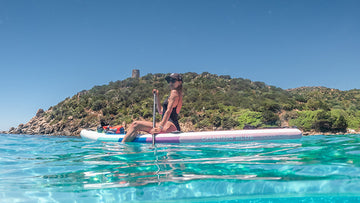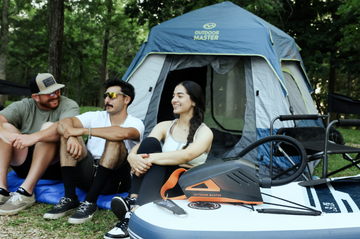
パドルボードは、水上で一日を過ごすのに最適な方法です。楽しくてやりがいのあるアクティビティであるだけでなく、優れた運動効果も得られます。パドルボードは、年齢やスキルレベルを問わず、どなたでもお楽しみいただけます。
しかし、水上に出かける前に、いくつか考慮すべき点があります。最も重要な要素の一つは、必要なパドルボードのサイズを決めることです。
パドルボードにはさまざまなタイプとサイズがあるため、適切なものを選ぶのは難しい場合があります。
この記事では、パドルボードを選ぶ際に考慮する必要があるさまざまな要素について説明し、ニーズに合った適切なサイズを選択する方法に関するヒントも提供します。
要因1:体重/身長
パドルボードを選ぶ際にまず考慮すべきことは、身長と体重です。自分の体格に合った大きさのボードを選ぶようにしましょう。
身長が高めの方は、長めのSUPボードをお選びください。逆に、身長が低い方や体格が小さい方は、短めまたは小さめのSUPボードの方が良い選択肢となるかもしれません。
要因2: スキルレベル

身長と体重に加えて、スキルレベルも考慮する必要があります。初心者の場合は、安定性と操作性に優れたボードを選ぶことが重要です。一方、経験豊富な方は、より機敏で反応性に優れたボードを選ぶとよいでしょう。
要因3:漕ぐ水の種類
パドリングする水の種類も重要な考慮事項です。穏やかで平坦な水面でパドルボードを楽しむなら、小さめで軽いボードでも十分です。
ただし、波が荒いときや風が強いときにパドル ボードに乗る場合は、安定性を確保するために、より大きく重いボードが必要になります。
要因4:意図された用途
4つ目に考慮すべき要素は、ボードの用途です。レースで使う予定なら、幅が狭く長いボードを選ぶと良いでしょう。一方、ゆったりとクルージングを楽しむためのボードを探しているなら、より大きく安定したボードを選ぶ方が良いでしょう。
要因5:予算
もちろん、他の考慮事項の 1 つは予算です。
いくつかの会社では、同じ大きなボードに比べてより安い価格で、より小型のパドルボードを提供しているので、パドルボードをたまにしか使用しないか、または静かな水でしか使用しない場合は、お金を節約するために小型のボードで済むかもしれません。
パドルボードの正確なサイズを見つけましょう

パドル ボードのサイズに何が影響するかが明確になり、パドル ボードを選択する際に考慮すべきさまざまな要素がわかったので、適切な SUP のサイズを見つけましょう。
長さ
-
長さ25cm以下のパドルボードは、SUPサーフィンにおすすめです。短いため操作性に優れています。私の知る限り、これらのボードは必ず滑走性があります。また、この長さのボードは小さなお子様にも適しています。
-
長さが10'1" - 11 フィートのパドル ボードは、あらゆるレベルのライダーに推奨されており、小柄な人にとっては理想的なオールラウンド SUP になります。
-
長さが 11'1 インチを超えるパドル ボードは上級ライダーに推奨され、直線を維持でき、速度が速いため、ツーリングやレース用のパドル ボードとして最適です。
幅
-
幅30 インチ未満のパドル ボードは、スピードは出ますが、不安定で揺れやすいため、上級パドラーにのみお勧めします。
-
幅が 30 ~ 32 インチのパドル ボードは、小柄な人に適した万能 SUP で、操作性も優れています。
-
幅が32 インチを超えるパドル ボードは、このスポーツを始めたばかりの人に適しています。
厚さ
-
厚さ6インチ未満のインフレータブルパドルボードは、通常推奨されません。インフレータブルタイプは、ボードがたわみすぎて不安定になる可能性があるためです。信頼できるブランドのもので、体重が軽い場合にのみ、インフレータブルタイプを選ぶことができます。
-
厚さ6 インチのパドル ボードは、あらゆるレベルの人に適した万能パドル ボードです。
市場にはさまざまなタイプとサイズのパドルボードが販売されていますので、時間をかけて自分のニーズに最適なものを見つけてください。
自分にぴったりのパドルボードを見つけたら、リーシュ、フィン、ライフジャケット、収納バッグなど、パドルボードに必要なアクセサリーも忘れずに購入しましょう。必要なギアが揃えば、すぐに水上に出て、新しいパドルボードを楽しむ準備が整います。
パドルボードの長さ表
|
パドラーの体重 |
オールラウンドSUP |
サーフサップ |
レースサップ |
|
124ポンド未満 |
9フィート0インチ未満 - 10フィート6インチ |
9フィート0インチ未満 |
9フィート1インチ - 11フィート6インチ |
|
124~150ポンド |
9フィート1インチ - 10フィート6インチ |
9フィート0インチ未満 |
10'7” - 11'6” |
|
150~174ポンド |
9フィート1インチ - 11フィート6インチ |
9フィート1インチ - 10フィート6インチ |
10'7” - 12'6” |
|
174~200ポンド |
10'7” - 11'6” |
9フィート1インチ - 10フィート6インチ |
12フィート6インチ |
|
200~224ポンド |
10'7” - 11'6” |
9フィート1インチ - 10フィート6インチ |
12フィート6インチ |
|
224~249ポンド |
10'7” - 11'6” |
9フィート1インチ - 10フィート6インチ |
12フィート6インチ以上 |
|
249~275ポンド |
11'7” - 12'6” |
9フィート1インチ - 11フィート6インチ |
12フィート6インチ以上 |
よくある質問
パドルボードが長いほどなぜ速くなるのでしょうか?
パドルボードが長いほど、あまり方向転換せずに直線を走れるため、スピードが上がり、レースやツーリングに適しています。
インフレータブルパドルボードは安定性が低いですか?
いいえ、インフレータブルパドルボードは通常、ハードボードよりも安定しています。膨らませると、より硬く、より安定します。唯一の例外は、インフレータブルパドルボードが非常に薄い場合(厚さが6インチ未満の場合)です。その場合は、安定性が低下する可能性があります。
ハードパドルボードとインフレータブルパドルボードのどちらが良いですか?
ハードパドルボードとインフレータブルパドルボードのどちらが良いか、明確な答えはありません。一般的に、ハードパドルボードは水上でのスピードが速く、インフレータブルパドルボードは持ち運びやすく、安定性があり、収納も簡単です。しかし、最終的には個人のニーズと好みによって決まります。
パドルボードが十分に膨らんでいるかどうかはどうすればわかりますか?
パドルボードの空気が十分に入っているかどうかわからない場合は、いくつか確認方法があります。まずは、メーカーが推奨するPSI(平方インチあたりの重量)を確認し、パドルボードがその数値になっているか確認しましょう。
「ピンチテスト」を行うこともできます。パドルボードの中央をつまんで押し込むと、硬く押し込めるはずです。簡単に押し込める場合は、空気が足りない可能性が高いので、空気を追加する必要があります。
最後に、「バウンステスト」を試してみましょう。パドルボードの中央で軽く跳ねてみましょう。十分に膨らんでいれば、ほとんどへこまないはずです。トランポリンで跳ねているような感覚であれば、膨らみが足りないので、空気を足す必要があります。
念のためお知らせしますが、圧力計が内蔵されたハンドポンプを使用している場合は、少なくとも約 7 PSI になるまでボード内の実際の空気圧を測定できない可能性があります。
読んでいただきありがとうございます!パドルボードについてもっと知りたい方、または同じ趣味を持つ仲間からアドバイスやサポートを受けたい方は、ぜひSUP専用のFacebookグループにご参加ください。ご参加をお待ちしております!






